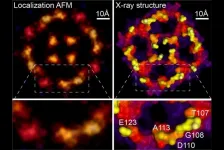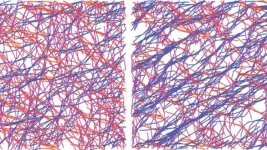MD Anderson research highlights for June 16, 2021
Featuring discoveries in AML, exosomes, hepatocellular carcinoma and C. difficile
2021-06-16
(Press-News.org) HOUSTON ? The University of Texas MD Anderson Cancer Center's Research Highlights provides a glimpse into recently published studies in basic, translational and clinical cancer research from MD Anderson experts. Current advances include a new combination therapy for acute myeloid leukemia (AML), a greater understanding of persistent conditions after AML remission, the discovery of a universal biomarker for exosomes, the identification of a tumor suppressor gene in hepatocellular carcinoma (HCC) and characterization of a new target to treat Clostridioides difficile (C. difficile) infections.
Utilizing combination therapy for AML
While a majority of patients with acute myeloid leukemia (AML) respond favorably to initial therapy, many will experience a subsequent relapse. Once relapse occurs, outcomes are poor and novel therapeutic options are needed. A study led by Courtney DiNardo, M.D., and Hagop Kantarjian, M.D., found that an intensive treatment regimen of fludarabine, cytarabine, granulocyte colony-stimulating factor and idarubicin (FLAG-IDA) combined with the B-cell lymphoma-2 inhibitor venetoclax is effective in both relapsed/refractory and newly diagnosed patients with AML. In the study group, anticipated and manageable side effects included chemotherapy-induced cytopenias and neutropenic infections. The combination therapy produced deep remissions and helped bridge patients to successful stem cell transplants. Learn more in the Journal of Clinical Oncology.
Examining clinical outcomes of AML post-remission clonal hematopoiesis
Clonal hematopoiesis (CH) is a condition that develops when a hematopoietic stem cell, which is a stem cell that typically develops into various types of blood cells, instead makes cells that all have the same genetic mutation. CH can lead to acute myeloid leukemia (AML), and it can persist after patients are in remission. A study led by Tomoyuki Tanaka, M.D., Ph.D, Kiyomi Morita, M.D., Ph.D., and Koichi Takahashi, M.D., Ph.D., examined 164 cases of AML and found that post-remission CH occurred in around half of the patients but had little impact on their risk of relapse, their non-relapse mortality or their risk of cardiovascular disease. The findings suggest that while CH after remission from AML is resistant to treatment, it generally does not negatively affect clinical outcomes. Learn more in Blood.
Discovery of a universal biomarker for exosomes
Exosomes are virus-sized, membrane-bound particles released by all cells that are thought to carry information important for cell-cell communication. Exosomes are produced at high levels by cancer cells and contain DNA, RNA and proteins that could be useful for cancer screening, diagnostics and treatment response monitoring. A new study led by Fernanda G. Kugeratski, Ph.D., and Raghu Kalluri, M.D., Ph.D., found that exosomes contain a core proteome of approximately 1,200 proteins common to exosomes from all cells. The researchers also discovered that syntenin-1 is the most abundant protein across all exosomes, making it a potential universal marker of exosomes. Such a protein marker makes it easier to isolate and study exosomes to clarify their function and to develop approaches for using exosomes in the clinic. Learn more in Nature Cell Biology.
Immune activating tumor suppressor for treating HCC
Hepatocellular carcinoma (HCC) is the leading cause of cancer deaths worldwide, and more research is required to fully understand the biology of this disease for developing effective treatment. A research team led by Shulin Li, Ph.D., discovered WSX1 acts as an 'immune' tumor suppressor gene in HCC, effectively downregulating neoplastic PD-L1 expression in abnormal hepatocytes or HCC cells to boost immune surveillance. The suppression of PD-L1 in HCCs by WSX1 occurs through de-stabilization of a novel subtype of AKT protein. This result uncovered a novel target for cancer immunotherapies to treat HCC. Learn more in Nature Communications.
Characterizing a new target for treating C. difficile infections
Clostridioides difficile (C. difficile) is one of the leading causes of hospital-acquired infections in the U.S., and more effective therapeutic interventions are needed. The recently discovered CamA enzyme, which appears to be specific to C. difficile, catalyzes DNA methylation and is essential for spore formation and biofilm production, making it an attractive therapeutic target. A research team led by Jujun Zhou, Ph.D.; John R. Horton, Ph.D.; Xing Zhang, Ph.D.; and Xiaodong Cheng, Ph.D., performed in-depth enzymatic and structural analysis of CamA to learn how it interacts with DNA to perform its role. Their crystal structure of CamA bound to DNA provide the roadmap necessary for developing drugs to block the protein's activity. Learn more in Nature Communications.
INFORMATION:
In case you missed it
Read below to catch up on recent MD Anderson press releases across the spectrum of cancer research.
Combination targeted therapy provides durable remission for patients with chronic lymphocytic leukemia
Targeted therapy pralsetinib safely and effectively treats lung and thyroid cancers with RET alterations
Newly approved targeted therapy sotorasib prolongs survival in KRAS G12C-mutated lung cancer
Glioblastoma study discovers protective role of metabolic enzyme, revealing a novel therapeutic target
About MD Anderson
The University of Texas MD Anderson Cancer Center in Houston ranks as one of the world's most respected centers focused on cancer patient care, research, education and prevention. The institution's sole mission is to end cancer for patients and their families around the world. MD Anderson is one of only 51 comprehensive cancer centers designated by the National Cancer Institute (NCI). MD Anderson is ranked No.1 for cancer care in U.S. News & World Report's "Best Hospitals" survey. It has ranked as one of the nation's top two hospitals for cancer care since the survey began in 1990, and has ranked first 15 times in the last 18 years. MD Anderson receives a cancer center support grant from the NCI of the National Institutes of Health (P30 CA016672).
ELSE PRESS RELEASES FROM THIS DATE:
2021-06-16
Scientists at Weill Cornell Medicine have developed a computational technique that greatly increases the resolution of atomic force microscopy, a specialized type of microscope that "feels" the atoms at a surface. The method reveals atomic-level details on proteins and other biological structures under normal physiological conditions, opening a new window on cell biology, virology and other microscopic processes.
In a study, published June 16 in Nature, the investigators describe the new technique, which is based on a strategy used to improve resolution in light microscopy.
To study proteins and other biomolecules at high resolution, investigators have long relied on two techniques: X-ray crystallography ...
2021-06-16
A new rubber band stretches, but then snaps back into its original shape and size. Stretched again, it does the same. But what if the rubber band was made of a material that remembered how it had been stretched? Just as our bones strengthen in response to impact, medical implants or prosthetics composed of such a material could adjust to environmental pressures such as those encountered in strenuous exercise.
A research team at the University of Chicago is now exploring the properties of a material found in cells which allows cells to remember and respond to environmental pressure. In a paper published on May 14, 2021 in Soft Matter, they teased ...
2021-06-16
PHILADELPHIA - Amyotrophic lateral sclerosis (ALS), also known as Lou Gehrig's disease, is a neurodegenerative disease that strikes nearly 5,000 people in the U.S. every year. About 10% of ALS cases are inherited or familial, often caused by an error in the C9orf72 gene. Compared to sporadic or non-familial ALS, C90rf72 patients are considered to have a more aggressive disease course. Evidence points to the immune system in disease progression in C90rf72 patients, but we know little of what players are involved. New research from the Jefferson Weinberg ALS Center identified an increased ...
2021-06-16
While crop yield has achieved a substantial boost from nanotechnology in recent years, alarms over the health risks posed by nanoparticles within fresh produce and grains have also increased. In particular, nanoparticles entering the soil through irrigation, fertilizers and other sources have raised concerns about whether plants absorb these minute particles enough to cause toxicity.
In a new study published online in the journal END ...
2021-06-16
Although each organism has a unique genome, a single gene sequence, each individual has many epigenomes. An epigenome consists of chemical compounds and proteins that can bind to DNA and regulate gene action, either by activating or deactivating them or producing organ- or tissue-specific proteins. As it is a highly dynamic material, it can provide a large amount of information to shed light on the evolution of the various tissues and organs that make up the body.
Now, a team from the Institute of Evolutionary Biology (IBE), a joint centre of the Spanish National Research Council (CSIC) and Pompeu Fabra University, has carried out the largest study to date on the regulatory ...
2021-06-16
By repurposing common ingredients in hair conditioner, scientists have designed an inexpensive, transparent coating that can turn surfaces like windows and ceilings into glue pads to trap airborne aerosol droplets. This new strategy is described June 16 in the journal Chem.
"Facing a pandemic, we need to proactively leverage all of the different layers of defense mechanisms, including the physical barriers," says corresponding author Jiaxing Huang, a professor of materials science and engineering at Northwestern University. "After all, these viruses must travel through physical space before reaching and eventually infecting people."
The ...
2021-06-16
Small modeling errors may accumulate faster than previously expected when physicists combine multiple gravitational wave events (such as colliding black holes) to test Albert Einstein's theory of general relativity, suggest researchers at the University of Birmingham in the United Kingdom. The findings, published June 16 in the journal iScience, suggest that catalogs with as few as 10 to 30 events with a signal-to-background noise ratio of 20 (which is typical for events used in this type of test) could provide misleading deviations from general relativity, erroneously pointing to new physics where none exists. Because this is close to the size of current catalogs used to assess Einstein's ...
2021-06-16
Human babies do even more than we thought while sleeping.
A new study from University of Iowa researchers provides further insights into the coordination that takes place between infants' brains and bodies as they sleep.
The Iowa researchers have for years studied infants' twitching movements during REM sleep and how those twitches contribute to babies' ability to coordinate their bodily movements. In this study, the scientists report that beginning around three months of age, infants see a pronounced increase in twitching during a second major stage of sleep, called quiet sleep.
"This was completely surprising and, for all we know, ...
2021-06-16
When Betelgeuse, a bright orange star in the constellation of Orion, lost more than two-thirds of its brightness in late 2019 and early 2020, astronomers were puzzled.
What could cause such an abrupt dimming?
Now, in a new paper published Wednesday in Nature, an international team of astronomers reveal two never-before-seen images of the mysterious darkening --and an explanation. The dimming was caused by a dusty veil shading the star, which resulted from a drop in temperature on Betelgeuse's stellar surface.
Led by Miguel Montargès at the Observatoire de Paris, the new images were taken in January and March of 2020 using the European Southern Observatory's Very Large Telescope. Combined with images previously taken in ...
2021-06-16
EMBARGOED UNTIL 11 A.M. ET WEDNESDAY, JUNE 16, 2021
MADISON, Wis. -- Quantum computers could outperform classical computers at many tasks, but only if the errors that are an inevitable part of computational tasks are isolated rather than widespread events. Now, researchers at the University of Wisconsin-Madison have found evidence that errors are correlated across an entire superconducting quantum computing chip -- highlighting a problem that must be acknowledged and addressed in the quest for fault-tolerant quantum computers.
The researchers report their findings in a study published June 16 in the journal Nature, Importantly, their work also points to mitigation strategies.
"I think people have been approaching the problem of error correction in an overly optimistic ...
LAST 30 PRESS RELEASES:
[Press-News.org] MD Anderson research highlights for June 16, 2021
Featuring discoveries in AML, exosomes, hepatocellular carcinoma and C. difficile


